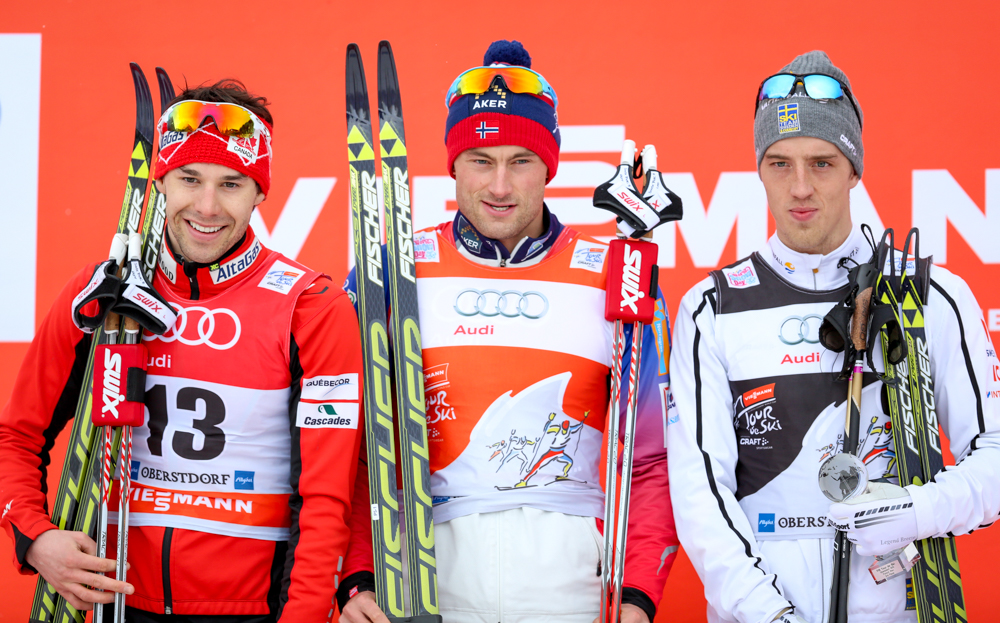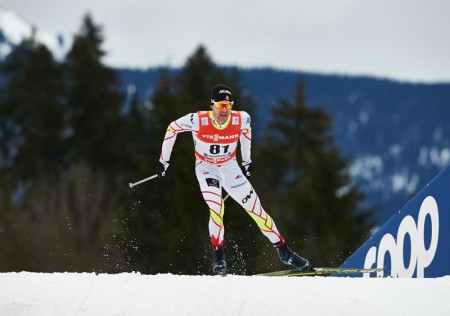
What is it about the Tour de Ski that works for someone like, say, Alex Harvey? In the last three years, the Canadian World Cup Team member has notched six podiums in the multi-stage event, including second place on Sunday in the men’s 15-kilometer classic pursuit in Oberstdorf, Germany, which put him second overall in the Tour after two stages.
And while he’s hit the podium in other World Cup and World Championships races, like at World Cup Finals last season, all but four of at least a dozen of his World Cup top 3’s have come from stage races — like the Tour.
On Sunday, he told Cross Country Canada that he likes the big stage: “I get excited but I think Oberstdorf the time of year that we race this is good for me,” he said.
After four weeks of racing to start the season, he explained that allows him to get back into top form.
“The timing of the Tour is just good for me,” Harvey added.
FasterSkier spoke with Harvey on the phone Monday, after he spent much of the afternoon resting and gearing up for Stage 3 of the Tour de Ski in Val Müstair, Switzerland.
The Canadian team stayed in a hotel 20 minutes from the venue and just across the border in Italy, near Malles, he said.
FasterSkier: How’s Switzerland?
Alex Harvey: It’s really sunny, there’s not much snow, but it’s nice weather out. … The snow and the track is good. It’s really fast snow. The corners are a bit icy — it’s all manmade snow.
It’s actually a lot like it was two years ago here [in January 2013] on the course, but [then] we could ski everywhere else down the valleys on natural snow, but the course was manmade snow just to guarantee the snow.
It’s green everywhere else other than on the race course, but it’s fine. We’re not trying to train or anything today. We just skied for like an hour, just more like a recovery ski kind of thing. It was on a 700-meter loop so it was good that it was only an hour workout.Oberstdorf
[Tuesday’s freestyle sprint is twice around the 700-meter loop. Race organizers had originally installed a jump, or sort of step down, as an added obstacle, but decided to remove it on Monday.]
FS: What did you think of that jump? Was it like the one at the Quebec World Cup (in December 2012)?
AH: For me, it was not really a problem, but I think some girls crashed in the corner.
It was pretty much the same height [as the one in Quebec, which was about 30 centimeters high], but it was in the middle of a downhill so you came up faster. I was actually just trying to absorb it, like in alpine, to not take any air to try to stay compact, but it’s pretty much the same height, but just on a downhill instead of a flat.
FS: How do the conditions in Val Müstair compare to what you skied on the first two stages in Oberstdorf?
AH: It’s more stable conditions, but Oberstdorf it was natural snow for most of it. They had a warmup loop in Oberstdorf and everything, like here, for sure tomorrow we’ll be running, but it’s gonna be pretty firm and fast snow here tomorrow.

FS: Looking back to yesterday’s pursuit: had you planned to race it that way?
AH: It was close to perfect, like six-tenths away from perfection, but no, it was good. I had really good skis. I felt good in the morning, like, I felt really ready, you know? You wake up and you’re fresh in your head and awake.
Testing skis, I felt like I had a good body and I knew I had a really good group off the start with Martin [Jaks of the Czech Republic] and Eldar [Rønning of Norway] and [Russia’s Maxim] Vylegzhanin. I knew those guys would be strong chasers to try to close back on [Swiss leader Dario] Cologna, and I was actually surprised how fast we came back. … Dario and Calle [Halfvarsson of Sweden], it doesn’t seem like they really tried to stay away so that was good for us. We came back after 3.5 k and I could recover from that effort and stay in good position. The rest was just fighting for good position to try to stay near the front and avoid crashes or breaking equipment, and have my own lane for the last climb. That was my plan and I did all of that.
FS: How stressful or chaotic was it trying to stay at the front of the pack for the rest of the race?
AH: Along the flats, guys were fighting pretty hard to be in position, but once I got near the front, I was behind [Norway’s Niklas] Dyrhaug in second place, and I took my own lane up the hill so from then on I knew nobody would go around me. There was only four tracks up the hill and I had my own track.
So for me, it was actually not that chaotic because I was in the front there on the hill. It was just the whole lap until that hill … everybody has the same plan. Everybody’s plan is to hit the base of the hill in the top four so they can choose one of the four tracks, so that’s where it was more chaotic, but once I was near the front and up the hill, it was actually a pretty smooth ride. It was painful, but I could ski in my own tracks so that was good.
FS: You stayed out of trouble on the right side then came up over the hill in the top four. What were you thinking then before the downhill and straightaway into the finish?
AH: I for sure didn’t want to hit the top of the hill in first because it’s just such a fast hill and quite a long straight. I wanted to have some kind of a draft, so the ideal position was maybe third to fifth, so I think I crested over the top in fourth. I wanted to give a bit of space to try to slingshot over the last bridge, but then things got a bit messy in the front so I had to go around these guys [including Italy’s Francesco De Fabiani].
I lost a bit of speed there, but my goal was just hit the top of the hill in the front and then, if a guy really wants to fight for one more position, I’ll give that position because I didn’t care. There would be a huge draft going down the hill. So I did that and things got a bit messy in the corner. I kind of went around first on the right then I cut left on the inside, and it was not perfect but it was good enough to come in second.
FS: What did you think of your double-pole finish?
AH: I always trust my double-pole finish so I was more happy that I was actually able to stay near the front the whole race. Sometimes I have to drift a bit on the climbs just because it gets too hard too early, so for me, I was able to put myself in a position where I was able to use one of my biggest strengths in classic, which is my double poling. I was happy that it was still there for sure, but I was more happy that I was able to actually stay near the front for the whole race.
FS: What is it about the Tour that often brings out your best?
AH: Like always, it’s a lot of different things, but this was a good start of the season, like seventh in Kuusamo was the best I could’ve asked for pretty much, so I knew I was coming in in good shape. But there is still a difference between seventh and a podium.
I feel like I always need a couple weekends of racing under my belt to really get going and I always kind of carry a fairly big training load during the first period of the World Cup just to really be confident that I can peak at the right time, which is for me, World Championships this year.
Because there’s always bit of fatigue and I don’t feel super, super sharp first period, I’m just not contending for the podium. But then you can start chilling a bit the last week of those first four races. The second weekend in Davos I could relax a bit, then I had a good training block with no races so I could do good volume in Livigno [Italy over the holiday break], then I had a bit easier time just after the New Year, then the Tour was starting so, I don’t know, it’s just the time of the year is good.
But also, we’ve always had a pretty small team at the Tour. This year it’s just four of us, so the logistics, who can get a massage right after the race and we can get in one car and we’re pretty fast to get out of the hotel and everything. I think when you start adding that, the later races for us are sometimes good. [In 2013], Len and I were second and third in the second-to-last stage; we’ve had good races near the end of the Tour. I think that’s the fact that we’re such a small team. We can be pretty efficient with the recovery and with transportation and moving from one site to the other, so I think that’s helping us down the stretch.
Mostly it’s the time of the year, the shape is starting to come around nicely now and can really race at a good enough level to contend at least for a podium.
FS: Since you’re not planning to do the final climb and final stage again, what are your overall goals for the Tour?
AH: For sure, it’s not about the overall, but last year, the long stage, the 35 k [freestyle pursuit from Cortina to Toblach, Italy], I was third there. You need to be in a good place in the overall to start in a good group to contend for the podium there, so I still need to have the next two races to have good results.
Tomorrow [my goal] is to get at least in the semis to get some bonus seconds, just to stay in a good position to head to Toblach and get in a good group to start that last day [the 35 k freestyle pursuit], and then the [10] k classic [on Wednesday] could be pretty sweet, the mass start, because I won’t be going for preems so I’ll hopefully be more fresh than the guys that went for preems on the last lap. So yeah, hopefully I can get another strong result there.
Alex Kochon
Alex Kochon (alexkochon@gmail.com) is a former FasterSkier editor and roving reporter who never really lost touch with the nordic scene. A freelance writer, editor, and outdoor-loving mom of two, she lives in northeastern New York and enjoys adventuring in the Adirondacks. She shares her passion for sports and recreation as the co-founder of "Ride On! Mountain Bike Trail Guide" and a sales and content contributor at Curated.com. When she's not skiing or chasing her kids around, Alex assists authors as a production and marketing coordinator for iPub Global Connection.



